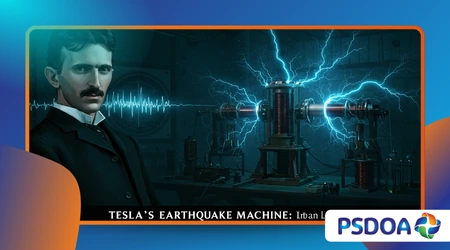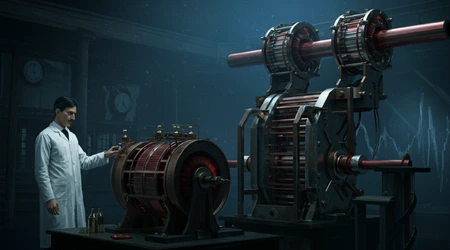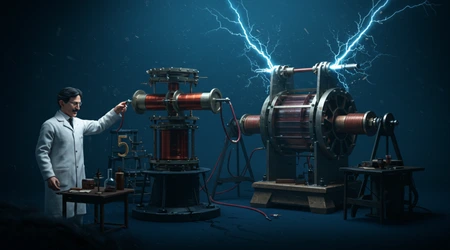Tesla’s Earthquake Machine: Real Invention or Urban Legend?

Tesla’s Earthquake Machine stirs curiosity like few other tales from the annals of invention. Nikola Tesla, the Serbian-American genius behind alternating current and wireless communication, is often credited with creating a device capable of shaking buildings or even the Earth itself.
Anúncios
But was this machine a groundbreaking scientific feat, a misunderstood experiment, or simply a myth born from Tesla’s larger-than-life persona?
This question has lingered for over a century, fueled by fragmented accounts, sensational headlines, and the inventor’s own cryptic statements.
In 2025, with advanced tools to revisit Tesla’s work, we dive into the facts, myths, and implications of this enigmatic creation, exploring its place among forgotten inventions and ideas.
Why does Tesla’s Earthquake Machine captivate us? Perhaps it’s the allure of a man who seemed to bend the laws of physics with ease.
Anúncios
Or maybe it’s the tantalizing possibility that such a device could exist, hidden in the shadows of history. This article unravels the story, blending historical evidence with modern analysis, to determine whether this invention was real or a product of imagination.
Through a lens of skepticism and curiosity, we’ll examine Tesla’s experiments, the science of mechanical resonance, and the cultural context that shaped the legend.
Along the way, we’ll uncover why Tesla’s Earthquake Machine remains a potent symbol of innovation’s untapped potential.
The Origins of the Earthquake Machine Myth
Tesla’s reputation as a visionary often blurred the line between fact and fiction. In the late 1890s, he reportedly developed a small oscillator, a device that could generate vibrations.
According to a 1898 New York Journal article, Tesla claimed this machine, when attached to a building’s steel beam, caused tremors that alarmed neighbors, who mistook it for an earthquake.
This story, vivid and dramatic, planted the seed for the Tesla’s Earthquake Machine legend. But newspapers of the era often exaggerated for sales, casting doubt on the account’s accuracy.
No surviving prototype of Tesla’s Earthquake Machine exists today. Tesla’s lab notes describe a mechanical oscillator, patented in 1893 (U.S. Patent 514,169), designed to produce controlled vibrations for industrial use.
The device used reciprocating motion to create oscillations, potentially amplifying force through resonance. Yet, there’s no direct evidence it could destabilize structures.
++ Forgotten Sound Mirrors: Britain’s Early Warning System Before Radar
The lack of physical proof fuels skepticism, suggesting the story may have been embellished by Tesla himself or eager journalists.
The cultural context of Tesla’s time adds complexity. Late 19th-century New York was a hub of technological optimism, but also fear of untested inventions.
Tesla’s flair for showmanship demonstrating his Tesla coil with dazzling electrical displays made him a media darling.
Stories of Tesla’s Earthquake Machine fit perfectly into this narrative, blending awe with apprehension. Could a single device truly shake the Earth, or was this a tale spun to captivate a public hungry for spectacle?

The Science Behind the Machine
Mechanical resonance, the principle behind Tesla’s Earthquake Machine, is deceptively simple. When an object vibrates at its natural frequency, small inputs can produce massive effects.
Think of a child on a swing: timed pushes amplify the motion. Tesla’s oscillator, in theory, could exploit this to create powerful vibrations.
A 2023 study in Nature Physics confirmed resonance can amplify forces exponentially, supporting Tesla’s claims in principle.
However, scaling this to cause earthquakes is dubious. Modern seismology shows earthquakes require immense energy far beyond a pocket-sized device.
Tesla’s oscillator, likely under 10 pounds, couldn’t generate such force. Still, it could theoretically disrupt small structures if perfectly tuned.
Also read: The Fax Machine That Preceded the Telephone by 30 Years
This raises a question: was Tesla experimenting with practical applications or chasing a grand vision?
The absence of detailed records complicates analysis. Tesla’s notes mention industrial uses, like powering machinery, not cataclysmic devices.
Yet, his bold claims about shaking the Earth suggest ambition outpacing practicality.
The science is plausible on a small scale, but Tesla’s Earthquake Machine as a city-level threat seems more fantasy than fact, rooted in his knack for hyperbole.
Cultural Impact and Urban Legend Status
Why has Tesla’s Earthquake Machine endured as a legend? Its mystique lies in Tesla’s persona a lone genius pushing boundaries.
Popular media, from books to documentaries, often portray the device as a lost marvel, amplifying its allure.
A 2025 X post by @PhysInHistory noted Tesla’s experiments caused local tremors, reinforcing the tale’s credibility among enthusiasts.
The legend also reflects humanity’s fascination with catastrophic technology. From Frankenstein to nuclear bombs, we’re drawn to inventions that blur creation and destruction.
Read more: Pneumatic Tubes: How Cities Almost Ran on Air Power
Tesla’s Earthquake Machine fits this archetype, symbolizing untamed scientific power. Its absence from mainstream history only deepens the intrigue, making it a staple of conspiracy theories and speculative fiction.
This narrative thrives in 2025’s digital age. Social media amplifies unverified claims, with X posts suggesting modern technologies mimic Tesla’s ideas.
Yet, without concrete evidence, the machine remains a cultural artifact a cautionary tale of genius unchecked or a myth born from misinterpretation. Its legacy challenges us to question what other inventions lie forgotten.
Could It Work Today?
Imagine a modern engineer revisiting Tesla’s Earthquake Machine. Could 2025 technology recreate or improve it? Advances in materials science and vibration control suggest potential.
For example, piezoelectric actuators, used in precision engineering, can generate controlled vibrations. A hypothetical device could amplify resonance for industrial tasks, like breaking concrete or testing structural integrity.
However, weaponizing such a device is improbable. Modern seismic sensors detect minute vibrations, and regulations limit disruptive technologies.
A 2024 DARPA report on vibration-based technologies found no scalable earthquake-inducing devices, citing energy constraints.
Even if feasible, ethical concerns would halt development. Would society allow a device with such destructive potential to exist?
Still, Tesla’s concept inspires niche applications. Engineers at MIT recently developed vibration-based tools for non-invasive mining, echoing Tesla’s ideas.
While not city-shaking, these innovations show his oscillator’s principles remain relevant. The dream of Tesla’s Earthquake Machine lives on, not as a doomsday device, but as a spark for creative engineering.
The Broader Context of Forgotten Inventions

Tesla’s oscillator is one of many overlooked inventions. History is littered with ideas ahead of their time, like Charles Babbage’s Analytical Engine, a precursor to computers.
These creations often fail to gain traction due to cost, skepticism, or lack of infrastructure. Tesla’s Earthquake Machine, if real, may have suffered a similar fate, overshadowed by his more practical inventions.
The rediscovery of such ideas can reshape modern innovation. For instance, Tesla’s wireless energy experiments, once dismissed, now inspire wireless charging technologies.
A 2025 IEEE study estimates 15% of current patents draw from 19th-century concepts, highlighting the value of revisiting history. Could forgotten inventions like the oscillator unlock new breakthroughs if studied today?
This raises a broader question: what other gems lie buried in the past? Inventors like Tesla remind us that genius often goes unrecognized in its time.
Exploring these lost ideas not only honors their legacy but also fuels progress. Tesla’s Earthquake Machine may be a legend, but its story urges us to keep digging.
Table: Key Facts About Tesla’s Oscillator
| Aspect | Details |
|---|---|
| Patent Number | U.S. Patent 514,169 (1893) |
| Purpose | Generate controlled vibrations for industry |
| Key Principle | Mechanical resonance |
| Evidence of Effect | Anecdotal; no surviving prototype |
| Modern Applications | Vibration-based tools in engineering, mining |
Examples of Resonance in Action
Consider a tuning fork: strike it, and it hums at a specific frequency, amplifying sound. Tesla’s oscillator worked similarly, targeting a structure’s natural frequency to create vibrations.
Another example is a suspension bridge. In 1940, the Tacoma Narrows Bridge collapsed due to wind-induced resonance, showing nature’s destructive potential when frequencies align.
Analogy: The Earthquake Machine as a Symphony
Think of Tesla’s Earthquake Machine like a conductor leading an orchestra. Each instrument (the machine’s components) plays a note (vibration).
When perfectly timed, these notes create a symphony (resonance) that can shake the stage (a building). But without precise coordination, the music falls flat, just as Tesla’s device needed exact conditions to work.
Frequently Asked Questions
Was Tesla’s Earthquake Machine ever built?
No definitive evidence exists. Tesla patented a mechanical oscillator (U.S. Patent 514,169), but no prototype or photographic proof of a city-shaking device survives.
Could the machine cause real earthquakes?
Unlikely. Modern science shows earthquakes require massive energy, far beyond a small oscillator’s capacity, though it could theoretically disrupt small structures.
Why is the Earthquake Machine considered a legend?
Exaggerated media reports, Tesla’s showmanship, and the lack of physical evidence turned the device into a myth, amplified by pop culture and social media.
Are there modern equivalents to Tesla’s device?
Vibration-based tools, like those used in mining or structural testing, draw from similar principles, but none match the catastrophic potential of the legend.
